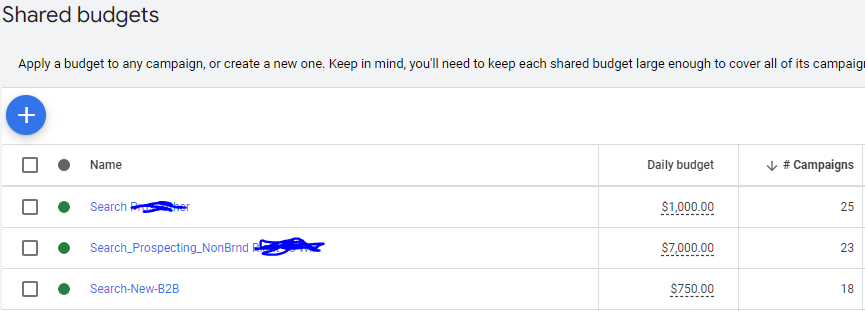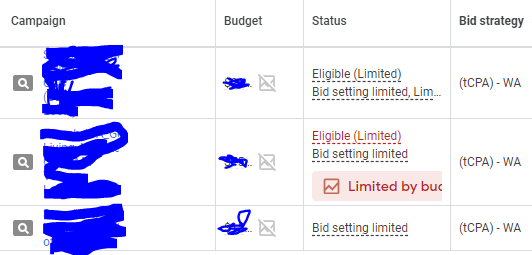In nearly 20 years in search marketing, something I continue to see and debate about is shared budgets.
When I ask the advertiser why, I always get a similar answer: “We have a set limited budget, and this is the best way for us to fund everything.”
Or, the one that truly pains me: “The engine sent me a rep for the fiscal quarter who recommended it along with a portfolio bid strategy to let it all work together.”
That is a response I get from mom-and-pop operations and SMBs, all the way up to major holding company ad agencies and Fortune 100 enterprise brands (if you fall into the latter and you went with the platform recommendation without questioning it, shame on you).
The reality is that sometimes this approach works fine, and other times, you are inadvertently shooting yourself in the foot, as your shared spend ends up limiting your potential return.
The Situation
A shared budget (often called a portfolio budget) does, in fact, help bandwidth-strapped operations (i.e., literally every marketing team on Earth) avoid overspending in a single engine. It can also complement a portfolio bid strategy in some scenarios positively.
 Image from author, October 2024
Image from author, October 2024However, a shared budget rewards the high-volume or high-demand elements first.
It’s essentially like attempting to work in the front office of the NY Jets – those who come in fast and with deep pockets get big-name players (who often don’t pan out), and everyone else loses out (especially the fans).
The Impact
Pairing a shared budget is cute until you realize you have a low conversion rate-producing campaign that has a high volume in traffic, sharing a budget with a campaign that has a low demand in traffic but is producing a high conversion rate.
Or, god forbid, you share a budget across campaigns that have different bid strategies or across different channels such as video and search (if you are mentally saying you’re doing this now, then you have messed up #ChangeMyMind).
Thus, the underproducing but high-volume campaign will take a disproportionate amount of the budget based on daily demand, potentially diminishing the opportunity or amount of time the high-producing campaign can show (as viewed in Impression Share and Impression Lost to Budget).
This is referred to as internal budget cannibalization.
Or when one entity takes a disproportionate amount of the total allotted budget against the entities with which it shares the funds.
 Image from author, October 2024
Image from author, October 2024This, in turn, reduces the aggregate performance (which can only be looked at as aggregate because they share the budget) of the campaigns sharing the budget.
To put this in a different perspective: This is like claiming all New York NFL teams are the best because the Jets and Giants combined have won five championships, but the Chiefs have only won four.
NY shares an NFL affiliation and has historical positive performance, but that can override recent positive performance of the Chiefs (assuming these two things were actually search campaigns sharing a budget and not pro football teams).
The Fallout
If you’ve read any of the above, this should be fairly straightforward, but to lay it out nicely: You treated two campaigns like they were equals and told them to share some money evenly.
This potentially will have left you with a missed opportunity for traffic and conversions.
If you share a budget between campaigns that have different themes (brand vs. non-brand), channel goals (search vs. video), or objectives (traffic vs. conversions), the problems will be immediately amplified.
The Fix
I should note that every operation is different. Some may not fall into this scenario, and some will – I see it more often in smaller agencies and brands strapped for bandwidth.
My personal preference, and I exercise this approach whenever I can, is to have standalone, daily budget caps for the individual campaign.
Note: I said daily. If this campaign is ongoing or evergreen, don’t use a campaign total; it’ll become a pain in the butt for you later. Only use campaign total for short campaign flights with predefined end dates.
From there, I work manually to keep the budgets fluid between campaigns – meaning that I will manually shift funds between campaigns. If one is outperforming another and can take on more budget, then I will make the necessary shift.
We make decisions on budget migration through manual tracking (which I prefer, though there are plenty of ways to do it) of spend pacing. I like to do this daily as it keeps us fresh, but you’ll know the right interval for your team.
Then, compare the campaigns against which campaigns are meeting or exceeding our objectives vs. those that are underproducing against the objectives.
When Are Shared Budgets Appropriate?
This is a bit subjective, but there are times when it can become appropriate.
One of the more common ones is when you’ve split your campaigns by devices (i.e., Campaign 1 is mobile-only, and Campaign 2 is desktop-only).
Here, presumably, the keywords, assets, and targeting are all the same, but it just so happens you have a justified reason to split the campaigns. So, having the campaigns share a budget is fine.
But you should closely monitor performance, as mobile often takes the lion’s share of traffic and may cause campaign cannibalization of desktop. (This was less of a problem back in the day when mobile cost per click (CPC) was significantly lower than desktop, but 55%-65% of the total traffic.)
This can also be applicable when multiple campaigns have the same assets and targeting but are splintered by match type at the campaign level – which, believe it or not, is still a common practice.
A shared budget works fine, and in theory, it would replicate the situation if you split the match types in a single campaign but at the ad group level.
The only caveat is that broad match will need to be watched like a hawk, as that often tends to be a driving force of search volume.
Another one is when using a portfolio bid strategy. When a group of campaigns share a single goal, and there is no disproportionate demand in volume, they can be put into a shared bid strategy.
This is a time when using a shared budget makes sense, as all elements are working together for a common goal (sort of like a Performance Max approach with the different ad units).
 Image from author, October 2024
Image from author, October 2024The Takeaway
First, a friendly reminder that shared budgets aren’t even applicable to all campaigns (i.e., campaigns in experiments or Performance Max don’t qualify to use them).
Next, if you are using shared budgets: Before you go and make changes to opt out of them after reading this inspirational article, you must first do some analysis.
In campaigns using a shared budget, look at things like:
- Is one campaign considerably outperforming another one in terms of return?
- Is one campaign consuming a disproportionate amount of the budget (and not the top performer of those who share the budget)?
- Do you have the bandwidth to manage and maintain individual campaign budgets? Always calculate the cost of manpower when doing return analysis.
- If they have a portfolio bid strategy, is the budget also shared?
If you do use shared budgets, make sure you account for the following (this is going to sound like a broken record, but deal with it):
- Brand and non-brand have different volume, different efficiency, different cost. If they are separated at the campaign level, then they shouldn’t share a budget.
- “Church and State Separation”: Display, Search, Shopping, and Video are different channels, are measured different ways, and serve different purposes. Therefore, sharing a single budget across channel types will lead to cannibalization.
- Make sure the campaigns you share budget for, have the same objective: traffic, conversions, etc.
If you’ve done this, and decided it would benefit you to try an individual budget over a shared one, then absolutely proceed and test it out.
Just keep in mind that you may see an improvement in your target campaign but run the risk of an adverse impact on the other campaigns that shared the budget.
Happy search marketing!
More resources:
- Keyword Match Types Still Matter (Phrase & Exact Match Are Not Obsolete)
- Agile Budgeting: What It Is, Why It’s Impactful, And How To Make It Work For You As A Marketer
- PPC Trends 2025
Featured Image: Vitaly_Vision/Shutterstock





